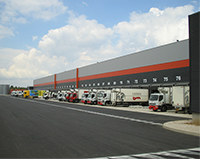Consolidation centres: less is more
Fifty into one does go. At least if you’re consolidating the number of deliveries to one of London’s prime shopping streets it does (see case study, below). The Crown Estate has cut trip deliveries to Regent Street retailers by around three-quarters since 2009 and AXA IM – Real Assets is hoping to achieve a reduction of 50% of daily deliveries when its planned 1.4m sq ft office building at 22 Bishopsgate, EC2, is fully operational at the end of this decade.
[gallery type="slideshow" ids="874168,874169,851925"]
Fifty into one does go. At least if you’re consolidating the number of deliveries to one of London’s prime shopping streets it does (see case study, below). The Crown Estate has cut trip deliveries to Regent Street retailers by around three-quarters since 2009 and AXA IM – Real Assets is hoping to achieve a reduction of 50% of daily deliveries when its planned 1.4m sq ft office building at 22 Bishopsgate, EC2, is fully operational at the end of this decade.
The idea of consolidation centres – standard warehouses outside an urban centre – isn’t new, but London’s increasing pollution and traffic congestion levels are giving the concept new impetus. “The success of any consolidation process relies on it being universally adopted. It needs a critical mass,” says Harry Badham, AXA’s UK head of development.
At 22 Bishopsgate, where the planning consent was conditional on the provision of a consolidation centre (see development box, below), office tenants will need to sign up to the consolidated delivery service as part of their lease terms. The specifics of the building’s consolidation centre are still being determined, but it is likely to be located in the A13 corridor.
This raises the tricky issue of land supply. “Consolidation centres are fine in theory but the reality might not be so easy if it is dependent on a plentiful supply of readily accessible industrial property,” says Piers Hanifan, industrial consultant at London-based agency Kalmars.
Paul Weston, senior vice president at developer Prologis agrees. “There are still inappropriate industrial sites in London. Why not move them out to elsewhere? And we need to seriously look at green belt land,” he says.
There is unlikely to be a standard size for future consolidation centres because the amount of space required is dependent on the area or building being serviced, so warehouses could range from a few thousand to more than 200,000 sq ft.
Delin Capital Asset Management, which is hoping to be behind many of the capital’s new consolidation centres, believes they will need to be within a 15-mile radius of central London, where the issue of competing land uses, particularly residential, is most acute. “That’s why we think there should be joined-up thinking with local authorities. Space could come from obsolete stock and other types of real estate,” says Delin’s managing director Ekaterina Avdonina.
One solution would be to locate centres further outside, where land supply is better. But then, says Steve Mitchell, director at Colliers International: “Customer expectations for quick delivery may be compromised by congestion if products are delivered from longer distances outside London and cannot get there on time.”
And wherever a consolidation centre is located it adds a layer of cost to any distribution network, points out TFT partner Seth Love-Jones, who notes that the operational costs of a centre will probably outweigh fuel and mileage saved by vehicles.
The economic viability of consolidation centres may end up being the hardest part of the equation to solve. Kieran Soobadoo, associate solicitor at legal firm Russell-Cooke, says: “To date, centres have been funded largely by subsidies, and they are expensive to run. Landlords and tenants will be wary of the implications of a consolidation centre closing. Where tenants are required to use a particular centre, care will need to be taken in the drafting of leases to cover this possibility.”
Anyone expecting a sudden ring of consolidation centres around the capital is likely to be disappointed. Savills industrial director Bridget Outtrim says: “I think it’s something that will gradually evolve. They are likely to appear with large office buildings – but how often do they come along?”
Demand for consolidation centres
As the immediate benefits of consolidation centres – cleaner air and less traffic congestion – are difficult for individual tenants to quantify and therefore cost effectively, it is perhaps unsurprising that neither developers nor industrial agents reports little demand for such buildings. “I’m not being bowled over in a rush for consolidation centres, though I think they will come eventually,” says Prologis head of London & South East markets, Paul Weston.
Enquiry lists remain disappointingly void of consolidation centre requirements, says Savills’ industrial director Bridget Outtrim. “This is going to be driven by policy [see development box, below] – a regulatory phenomenon that will create demand,” she adds.
One of the reasons 3PLs and other operators aren’t enthusiastic about the concept is that it is currently seen as a model associated with other countries, rather than the UK, reports Seth Love-Jones, partner at property consultancy TFT.
Case study – the Crown Estate
Think Crown Estate and “early adopter” may not be the first phrase you associate with the landlord. However back in 2009, in the depths of recession, when the term consolidation centre was practically unknown in London, the Crown Estate set up an operation to coordinate deliveries to its retailer tenants in the heart of the West End.
The impetus for the project was a desire to reduce the volume of traffic on the famous shopping streets. The Crown Estate partnered with specialist Clipper Logistics to filter deliveries to participating retailers to a 76,000 sq ft warehouse at Harlow, Essex, before making the trip into the capital in one of two electric lorries. Now 50 retailers (around half of all retail tenants) use the service and the number is rising.
“It’s useful for them to have a plug-and-play logistics solution,” says Crown Estate portfolio manager Bob Dawson. Is it worth the money? Dawson suggests that the cost increase is marginal and outweighed by the benefits to local store environments. Critics, however, point out that many retailers have still not opted in. Dawson responds: “Our preference is not to enforce, but to try and persuade. We have to remember that some retailers have long-standing relationships with existing suppliers or their delivery arrangements are made nationally.”
The biggest issue faced by the operation so far has been getting replacement supplies for the electric vehicles. A smaller electric vehicle is used for a separate consolidation scheme run by the Crown Estate to collect restaurant waste in the Swallow Street area. At present there is no waste consolidation on Regent Street (the offices there generate a surprising volume, reports Dawson), though the Crown Estate is considering how this might be achieved in the future.
Carrot and stick to encourage development?
The absence of a profusion of consolidation centres around the capital when there is broad agreement that the concept is not only sound but necessary suggests that the market may need some help to get centres established. Some see this as inevitable. Harry Badham, UK head of development at AXA IM –Real Assets, developer of 22 Bishopsgate, says: “It will almost become mandatory for new office buildings.”
Yet, so far, London’s local authorities have been exceedingly cautious about telling the market what to do. A few, such as Camden, Waltham Forest, Enfield and Islington, have worked jointly on a small-scale consolidation centre for their own deliveries, but key authorities like Westminster and the City of London have not made any firm pronouncements on the subject.
That may soon change. The City Corporation is due to discuss the topic in more detail later this year. “We’re still in the very early stages. At the moment we’re encouraging developers and business to look at this,” says director of built environment Carolyn Dwyer. Could the carrot turn into a stick? Dwyer is non-committal: “The last two large planning consents included the requirement for a consolidation centre. It will become a standard requirement that new developments have an environmental management plan. And that may or may not include use of a consolidation centre.”
Some of those who may provide future consolidation centre buildings are convinced that regulation is inevitable. “It will be a top-down approach – it won’t come from tenants voluntarily, but through changes in the planning regime,” says Ekaterina Avdonina, managing director at Delin Capital Asset Management.











